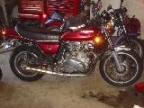- Posts: 1397
- Thank you received: 7
comp ratios
- 77KZ650
-
 Topic Author
Topic Author
- Offline
- User
07 MDP Rookie of the Year
01 ZX-12R street/drag bike. 8.97 @155.7 pump gas, dot tires, no bars, no power adders. top speed in the 1/4: 161MPH
Please Log in or Create an account to join the conversation.
- Snakebyte
-

- Offline
- User
- Posts: 550
- Thank you received: 2
Please Log in or Create an account to join the conversation.
- steell
-

- Offline
- User
Dynamic compression is what the engine actually "sees".
Back in the 60's Chevrolet HiPo motors had a static (advertised) compression ratio of 12.5:1, but due to valve timing overlap (allowing compression to bleed out the exhaust) the actual (dynamic) was closer to 9:1.
One of the Nascar classes runs a 17:1 ratio, but due to carb restriction the actual (dynamic) is ~10:1
Static ratio assume that the cylinder is completely full (atmoshereic pressure) at BDC, and during actual operation that is seldomly the case.
KD9JUR
Please Log in or Create an account to join the conversation.
- RomSpaceKnight
- Offline
- User
- Posts: 452
- Thank you received: 2
Please Log in or Create an account to join the conversation.
- steell
-

- Offline
- User
The limiting factor is peak cylinder pressure, and the limiting factor there is the octane rating of the fuel used (92 octane normally today).
For more info, please read the following:
www.sdsefi.com/meltdown.htm
Engine Performance
I should have remembered Speedomotive
"Compression Ratio" as a term sounds very descriptive. However, compression ratio by itself is like torque without RPM or tire diameter without a tread with. Compression ratio is only useful when other factors accompany it. Compression pressure is what the engine actually sees. High compression pressure increases the tendency toward detonation, while low compression pressure reduces performance and economy. Compression pressure varies in an engine every time the throttle is moved. Valve size, engine RPM, cylinder head, manifold and cam design, carburetor size, altitude, fuel, engine and air temperature and compression ratio all combine to determine compression pressure. Supercharging and turbo-charging can drastically alter compression pressures.
In 1936 the Enfield 'JF' was considered a superb, smooth machine with a very modern and efficient four-valve engine.
And a 100 mph 350cc motorcycle from a British company named Chater-Lea
The company's last motorcycle sales were in 1936. Their best machine was a 350cc ohc which at 100mph was the world's fastest 350cc machine
And Excelsior (another British company)
Notice the "Four valves and water cooled"The four-valve 250cc Manxman was released in 1935, later produced in 350 and 500cc sizes, as well as a 250cc model with fully-enclosed, water-cooled engine.
www.ianchadwick.com/motorcycles/enfield
www.ianchadwick.com/motorcycles/britbikes/brit_a.htmlThe AJS 500cc V-four was launched in 1935, initially as a roadster. It had chain-driven single overhead cams, front-mounted supercharger. Initially air-cooled, it became liquid-cooled in 1939
And that's just the British.
I better quit before this post becomes two pages long :laugh:
Post edited by: steell, at: 2006/01/31 22:26
KD9JUR
Please Log in or Create an account to join the conversation.
- wireman
- Visitor
Please Log in or Create an account to join the conversation.
- 77KZ650
-
 Topic Author
Topic Author
- Offline
- User
- Posts: 1397
- Thank you received: 7
Scott
07 MDP Rookie of the Year
01 ZX-12R street/drag bike. 8.97 @155.7 pump gas, dot tires, no bars, no power adders. top speed in the 1/4: 161MPH
Please Log in or Create an account to join the conversation.
- TwoSeven
- Offline
- User
- Posts: 34
- Thank you received: 0
Here are my thoughts (which may not be right - so feel free to correct).
So a bike might be designed for say a 12:1 compression ratio, but in real life only 85% of the cylinder is being filled on the intake, which means the real dynamic compression ratio is much lower - say roughly 10:1
Secondly, when a gas is compressed it heats up - compress it enough and it will self ignite - this is the principle that diesel engines used. It also means that there is a maximum compression ratio limit for petrol based engines. Its roughly about 14:1 or 15:1 (the lower limits of diesel engines).
Plugs are designed to wick heat out of the engine thru the cylinder head, and to self clean. Fuel is also used to cool and lubricate the engine, so you need to match the fuel and plugs together. The range you want is between 400C (the minimum temp that a plug will self clean) and 800C (the maximum plug temp before the tip melts or it cannot transfer heat) [I assume ngk plugs].
Octane is a retardent put in fuel - it doesnt really burn (its the hexane and O2 that does), so the more octane in the fuel (can never be more than 100%) the more resistant to burning the fuel will be. So if straight cut (unrefined) fuel is 87 octane - it will burn at about 400C, 98 octane will burn roughly at 800C (these are not the correct numbers, just to highlight the issue).
The spark plug only initiates the fuel burn (since its not diesel and not compressed to its flash point - it needs an assistor). If the fuel wasnt pre-heated by compression it would just put out the spark (like a firehose) - this is what happens when the engine floods with too much fuel. Once its compressed and ready to go the spark plug, initiates the burn.
The more mix you have compressed the bigger the bang [actually burn since bang is not terribly good] when its ignited, so the more powerful the power stroke, and more torque is produced on the crank. So more compression = more power but at a higher temperature.
You can also look at it another way. If you want to keep the power the same, then rasing the compression requires less fuel to be used - so it becomes more economic - both on fuel usage and fuel production.
As to why it wasn't done ages ago. First of all fuel couldnt be refined as well, then the materials (cast iron) couldnt cope with the heat produced, nor could the cylinder head design cope with the pressures involved.
Please Log in or Create an account to join the conversation.
- wireman
- Visitor
Please Log in or Create an account to join the conversation.
- MDawnz1
-

- Offline
- User
- Posts: 328
- Thank you received: 27
So is Steell...........
This CAN easily turn into a multi page post...
Check out a book "hot rod math"
It will either help you out OR drive you nuts.
1974 Z1a, still 903
Please Log in or Create an account to join the conversation.
- 79MKII
-

- Offline
- User
- Love Them Kaws!
- Posts: 2494
- Thank you received: 43
I've searched and haven't been able to find a straight answer to the question below -
What's the minimum octane fuel needed when running high compression pistons (12:1 or 13:1, drag race type pistons) in our KZ's? I'm considering going to the higher compression pistons but I'm not sure if I can run on pump gas. Anyone have experience with this? Thanks
The Kaw List:
Current: 79 KZ1000 A3 MKII, 78 KZ1000 A2, 78 KZ1000 Z1-R, 78 KZ650 SR, 80 KE175
Former: 03 KLX400SR, 99 ZRX1000, 82 KZ750 LTD, 80 KZ1000 A4 MKII, 80 KZ1000 LTD, 78 KZ1000 A2, 74 H-2 750 Triple, 78 KL250
Please Log in or Create an account to join the conversation.
